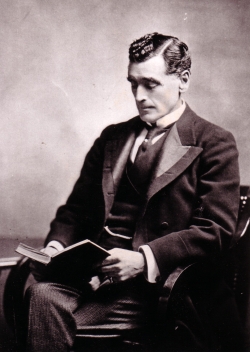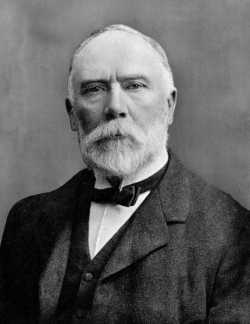Local Pioneers
This page tells the story of just a few of Tayside's many medical pioneers. You can see material relating to all of them in the Medical History Museum.
Thomas Maclagan
Dr Thomas J Maclagan (1838-1903)
Maclagan was Medical Superintendent at Dundee Royal Infirmary in 1864-66. During this time he had to cope with a major fever epidemic, leading him to pioneer the clinical use of thermo-meters. His most important work, however, was the research he carried out into the anti-rheumatic effects of salicin, a chemical extracted from willow bark. Maclagan's work was taken up by German researchers who used salicin to develop acetyl-salicylic acid - better known today as aspirin.
Maclagan later moved to London and established a fashionable practice whose patients included Thomas Carlyle and members of the Royal Family. At the time of his death in 1903, it was said that he "deserves a niche in the Temple of Fame as one of the great benefactors of the human race."
Maclagan's original microscope is in the Medical History Museum's collection.
Sir James Mackenzie (1853-1925)
Born at Pictstonhill near Scone, Mackenzie was a celebrated heart specialist. After studying in Edinburgh he set up practice for many years in Burnley, Lancashire. Mackenzie's particular interest was in diseases of the heart. Recognising the limitations of the sphygmograph to record the pulse, he pioneered a device which he called a polygraph. It allowed for the first time simultaneous recordings of the arterial and venous pulses to evaluate the condition of the heart and to measure the AV interval (the time between an atrial polarisation and the next ventricular polarisation). The polygraph would go on to revolutionise the diagnosis of heart problems, and later became the basis for lie detectors.
Mackenzie also discovered premature ventricular contractions and drew attention to the question of the heart's capacity for work, paving the way for the study of the energetics of the heart muscle. He also demonstrated the effectiveness of digitalis in the treatment of arrhythmias.
In 1907 Mackenzie left Burley and became a successful consulting physician in London. In 1915 he was elected a Fellow of the Royal Society and was awarded a knighthood. In 1918 he founded the influential Mackenzie Institute of Clinical Research in St Andrews, which involved local GPs in detailed long-term recording of patients' symptoms and illnesses.
The Medical History Museum has two early polygraphs as well as a bronze bust of Mackenzie.

Sir James Mackenzie
(Courtesy of Wellcome Library, London)

George Pirie
(Courtesy of Dundee Central Library)
Dr George A Pirie (1863-1929)
Pirie pioneered the application of X-rays to clinical medicine in Dundee. He established the first Electrical Department at Dundee Royal Infirmary in 1896 and worked there until 1925 when he retired due to ill-health. His long exposure to x-rays cost him his eyesight and both his hands had to be amputated due to radiation damage. In 1926 he was awarded a civil list pension and a Carnegie Hero Trust medal. The grateful citizens of Dundee organised a public collection for him, raising over £1,200. His name was also one of those inscribed on a memorial in Hamburg recognising early X-ray martyrs. The inscription reads:
"They were heroic pioneers for a safe and successful application of X-rays to medicine. The fame of their deeds is immortal."
The Medical History Museum holds several examples of Pirie's X-ray equipment, including early X-ray tubes, fluoroscope, protective face mask and a bottle of mustard oil, used by Pirie to ease the pain in his hands caused by repeated radiation exposure. One of Pirie's tumour-ridden hands is kept by the Pathology department at Ninewells Hospital.
Watch a video about Pirie and X-Rays in Dundee.
Dr James Riley (1912-1985)
A native of Settle in Yorkshire, Jim Riley was a surgeon during the war but had to retrain in radiotherapy when he contracted a skin condition on his hands. He was consultant at Dundee Royal Infirmary until 1974.
Dr Riley had always been fascinated by research and was an avid reader of the great heroes of the past such as Paul Ehrlich. He is said to have owned one of the great man's famous instruction blocks, which were notoriously difficult to decipher. While still a medical student Ehrlich was the first to describe the mast cell in humans, although left it to others to solve the riddle of what it does.
Jim Riley set out to solve this riddle, and made a good start with a notable series of experiments conducted during the 1950s in a corner of his room at DRI. This research into the mast cell made him an internationally respected authority, and led to a Claude Bernard Visiting Professorship in Montreal and election as a Fellow of the Royal Society of Edinburgh.
Much of Riley's original laboratory equipment was recently donated to the Medical History Museum by his family.

James Riley